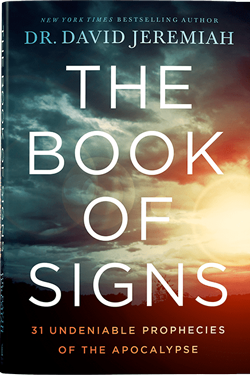Like a powerful telescope, the Bible is focused on one central theme, beginning at Genesis. Everything in Scripture supports that theme:
Establishing Jesus Christ as the rightful ruler over all of God’s creation.
You have no doubt used one of the “mapping” features available on the internet—Google Maps is perhaps the most commonly used. It enables you to focus on a particular location in the world; then, you can pull back to see the larger picture. You can go from a bird’s-eye view to an airplane’s perspective to a satellite’s view. Truly amazing!
Christ’s Second Coming Is the Central Theme of the Bible
Christ Is at the Beginning, Middle, and End of History
1. Key prophets.
2. Key passages for the future.
3. Key prophecies of the past.
4. Key purposes of God's writing prophets.
Prophecy and Christ’s Second Coming
For example, imagine finding Niagara Falls on Google Maps and, for the first time, picturing it as more than just a massive waterfall. You see its place on the Niagara River that divides Canada and the United States, flowing out of Lake Erie and into Lake Ontario. Who knew?
Or, when viewing Central Park in New York City, you zoom out and, for the first time, realize that Central Park is in Manhattan and surrounded by water on three sides. Does water encircle New York City? Who knew?
Or maybe you’re inspecting your own neighborhood—as you zoom out, you suddenly see geographic features you never knew were so close by—parks, lakes, great swaths of forest or rough terrain, or miles of rural roads perfect for biking. Who knew you lived in such a fascinating place?
I’m sure you know the expression, “We couldn’t see the forest for the trees,”—meaning our perspective is so myopic (nearsighted) that we fail to see the big picture. We see our house, our street, and our town, but we don’t envision the world. We view a single tree and admire its uniqueness while failing to see the grandeur of the forest.
Christ’s Second Coming Is the Central Theme of the Bible
It’s also possible to perceive a variety of biblical “trees” (details) while never gaining a clear picture of the “forest” (the big picture). We have favorite biblical characters and events, even favorite books of the Bible, but not always a clear understanding of God’s big picture—what God is doing from Genesis to Revelation and every step along the way.
When it comes to the Bible, “all Scripture is given by inspiration of God, and is profitable” (2 Timothy 3:16). Jesus said every “jot” and “tittle” of God’s revelation is vital (Matthew 5:18). Following our trees and forest metaphor, we might say that every tree in Scripture is worth our detailed attention. There is nothing wrong with having favorite characters, events, books, and verses from the Bible. But we also need to understand how they all tie together.
Like a powerful telescope, the Bible is focused on one central theme, beginning at Genesis. Everything in Scripture supports that theme: Establishing Jesus Christ as the rightful ruler over all of God’s creation. From the very beginning, the Bible has focused on the final chapter and verse of the story. From the very beginning, and all along the way, the writers of Scripture have been writing about—generally or in detail, knowingly or unknowingly—what we call today “the End Times.”
Therefore, the writers of Scripture have prepared God’s people for the climax of world history in which Christ will rule the world for a thousand years from His throne in Jerusalem.
Christ Is at the Beginning, Middle, and End of History
Jesus Christ is “the Alpha and the Omega, the Beginning and the End, the First and the Last” (Revelation 22:13). That passage stands at the end of world history just as Genesis 3:15 stands at the beginning: “And I will put enmity between you and the woman, and between your seed and her Seed; He shall bruise your head, and you shall bruise His heel.”
That verse, enigmatic when read by itself, is the first announcement that a descendant of Eve would come to destroy the serpent, Satan, whose temptations ruined the world. Bible scholars call it the protoevangelium—the first mention of the Gospel in the Bible. God says that the natural enmity between human beings and snakes will stand as a permanent reminder of the enmity between Satan and God—and a promise that the wounded heel of a descendant of Eve will one day crush the serpent’s head (Revelation 12:14-15; 20:2).
That promise of God sets the stage for the rest of Scripture which John, the writer of Revelation, well understood. It was John who wrote that Jesus Christ came into the world “that He might destroy the works of the devil” (1 John 3:8). And it was John who saw, in his apocalyptic vision, Satan and his angels fall from heaven to earth (Revelation 12:7-9).
So Christ is the Beginning and the End of God’s story of redemption. All the writers of Scripture contributed part of the story that points to the future enthronement of Jesus Christ as King of kings and Lord of lords (Revelation 19:16).
Prophecy and Christ’s Second Coming
Following the words of God Himself in Genesis 3:15 concerning the future victory of the Messiah over Satan, God’s subsequent writing prophets saw various dimensions of Jesus’ life leading up to His eventual kingship at His Second Coming.
Key prophets.
Both Zechariah (Zechariah 9:9) and an unnamed psalmist (Psalm 2:6) foresaw the coming of Christ as a King. Isaiah prophesied that the Messiah would come as a ruler who would bring peace and whose government would never end (Isaiah 9:6-7). Micah also saw the Messiah coming as a “Ruler in Israel” (Micah 5:2). Daniel envisioned the Messiah’s future kingdom destroying all other empires of this world (Daniel 2, 7) as well as the final judgment of all humanity (Daniel 12:2-3). Zechariah also wrote about many other facets of Christ’s return to earth and the establishment of His earthly kingdom. Actually, it would be easier to write a short list of prophets who didn’t prophesy about the End Times!
Receive Daily Devotions from David Jeremiah
Sign up to receive email devotions each day!
Key passages for the future.
The prophet Daniel gave us more than one critical passage for students of the End Times to study. The interpretation of Nebuchadnezzar’s dream provides a paradigm for Gentile kingdoms of the world that will yield to the the kingdom of God’s Messiah (Daniel 2:24-45). Daniel’s prayer for forgiveness for Israel resulted in the vision of “Daniel’s 70 Weeks”—an outline of the time of the Gentiles, the death of the Messiah, the treachery of the Antichrist, the persecution of Israel during the Tribulation, and the Antichrist’s final judgment (Daniel 9:20-27). Malachi wrote a powerful description of Christ’s Second Coming as Judge and King (Malachi 3:1-4). Isaiah’s prophecies contain many classic passages concerning Christ and the End Times: universal peace (Isaiah 11), Tribulation troubles (Isaiah 24), Millennial blessings (Isaiah 35), the future glory of Jerusalem (Isaiah 60–62), coming judgment and salvation (Isaiah 63–65), and life under the Messiah’s rule (Isaiah 65:17-24). Ezekiel’s dramatic vision of the valley of dry bones pictures Israel’s restoration (Ezekiel 37). And Zechariah saw multiple visions of the End Times: the blessing of Jerusalem (Zechariah 8), Israel’s mourning at Christ’s Second Coming (Zechariah 12:10-14), and Christ’s return to the Mount of Olives in Jerusalem (Zechariah 14).
Key prophecies of the past.
We can embrace the predictions concerning Christ’s Second Coming because they are the last prophecies in a long line of hundreds of predictions that Christ already fulfilled at His first coming. These signs and their fulfillment—concerning Christ’s lineage, birth, ministry, death, and resurrection—are well established and serve as guarantees of the prophecies yet to be fulfilled.
Key purposes of God's writing prophets.
A foundational verse concerning the purpose of God’s writing prophets is Amos 3:7: “Surely the Lord God does nothing, unless He reveals His secret to His servants the prophets.” Through His prophets, and later through the New Testament apostles’ writings, God has given those who are spiritually hungry insights into the past, present, and future of His redemptive plan. Central to all His Word, from Genesis to Revelation, is the role of God the Son in restoring humanity and creation to a condition that brings eternal glory to the triune God.
As we read the Bible, let’s relish the forest and the trees—the big picture of redemption and the details—so we will grow in appreciation for the centrality of Jesus Christ as His Second Coming approaches.

Terms such as these are both fascinating and frightening for any student of God’s Word. They point to key questions people have wrestled with for centuries.
In The Book of Signs, Dr. David Jeremiah offers answers to these questions and many more. Drawing from decades of study, Dr. Jeremiah explains every key sign of the approaching apocalypse and what it means for you.
